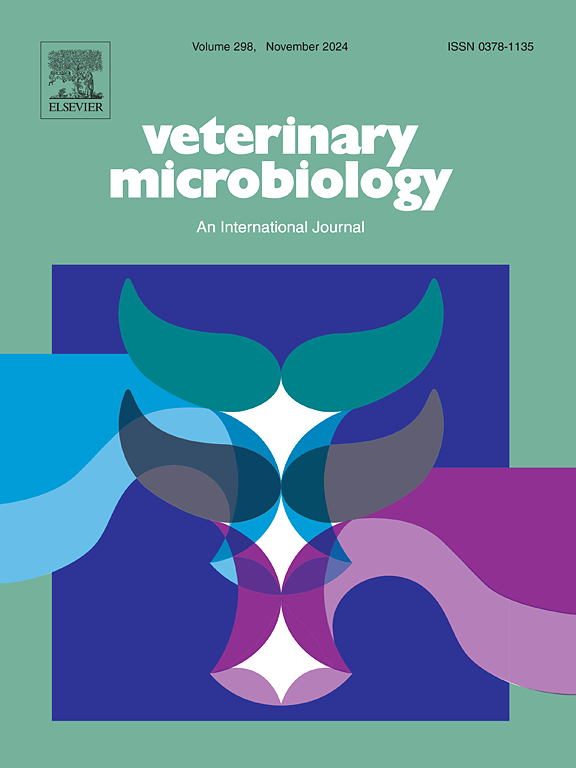通过猎枪元基因组学对 43 例马驹泰泽病尸检病例进行回顾性调查,并对皮里福尔梭菌的部分基因组序列进行研究
IF 2.4
2区 农林科学
Q3 MICROBIOLOGY
引用次数: 0
摘要
本文章由计算机程序翻译,如有差异,请以英文原文为准。
Retrospective investigation of 43 necropsy cases of Tyzzer disease in foals and partial genome sequence of Clostridium piliforme by shotgun metagenomics
Clostridium piliforme is an obligate intracellular filamentous bacterium that causes Tyzzer disease (TD) in many animals. The disease manifests as severe, multifocal necrotizing hepatitis, with a high fatality rate in foals. Through retrospective investigation, we detected C. piliforme in 43 equine necropsy cases from 2012 to 2024. Positive cases were diagnosed from February to July, peaking in May. The age of affected foals ranged from 4 days to 2 months. Histologically, all cases had necrotizing hepatitis with multifocal, coalescing pinpoint, tan or reddish foci. Since only a partial 16S rRNA gene sequence was available for the horse strain of C. piliforme, we used shotgun metagenomics to obtain its genome sequence from the liver of a necropsied foal with TD. The sequences obtained were compared against the NCBI NT/NR database with the highest number of reads and contigs aligning to Clostridium species. A complete 16S rRNA gene was obtained, showing the highest identity to a 16S rRNA gene of the horse strain of C. piliforme (99.05 %), followed by 98.02–96.71 % identities to rabbit and rodent strains of C. piliforme, indicating cross-species variation. Additional identified genes included alveolysin, exo-α-sialidase, flagellar and spore formation/vegetation, providing the first genetic evidence of virulence factors for C. piliforme. Furthermore, presence of genes encoding multidrug export and multidrug resistance proteins suggested C. piliforme could develop resistance to beta-lactams and fluoroquinolones. This study provides the first partial genome sequence of C. piliforme using a shotgun metagenomics hepatic sampling approach on a foal with TD.
求助全文
通过发布文献求助,成功后即可免费获取论文全文。
去求助
来源期刊

Veterinary microbiology
农林科学-兽医学
CiteScore
5.90
自引率
6.10%
发文量
221
审稿时长
52 days
期刊介绍:
Veterinary Microbiology is concerned with microbial (bacterial, fungal, viral) diseases of domesticated vertebrate animals (livestock, companion animals, fur-bearing animals, game, poultry, fish) that supply food, other useful products or companionship. In addition, Microbial diseases of wild animals living in captivity, or as members of the feral fauna will also be considered if the infections are of interest because of their interrelation with humans (zoonoses) and/or domestic animals. Studies of antimicrobial resistance are also included, provided that the results represent a substantial advance in knowledge. Authors are strongly encouraged to read - prior to submission - the Editorials (''Scope or cope'' and ''Scope or cope II'') published previously in the journal. The Editors reserve the right to suggest submission to another journal for those papers which they feel would be more appropriate for consideration by that journal.
Original research papers of high quality and novelty on aspects of control, host response, molecular biology, pathogenesis, prevention, and treatment of microbial diseases of animals are published. Papers dealing primarily with immunology, epidemiology, molecular biology and antiviral or microbial agents will only be considered if they demonstrate a clear impact on a disease. Papers focusing solely on diagnostic techniques (such as another PCR protocol or ELISA) will not be published - focus should be on a microorganism and not on a particular technique. Papers only reporting microbial sequences, transcriptomics data, or proteomics data will not be considered unless the results represent a substantial advance in knowledge.
Drug trial papers will be considered if they have general application or significance. Papers on the identification of microorganisms will also be considered, but detailed taxonomic studies do not fall within the scope of the journal. Case reports will not be published, unless they have general application or contain novel aspects. Papers of geographically limited interest, which repeat what had been established elsewhere will not be considered. The readership of the journal is global.
 求助内容:
求助内容: 应助结果提醒方式:
应助结果提醒方式:


